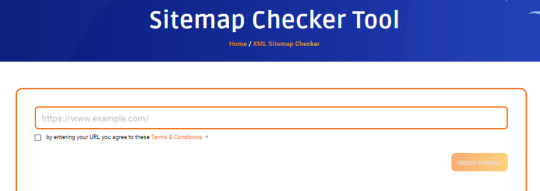#sitemap xml
Explore tagged Tumblr posts
Text
Sitemap – What it is, Types, Importance Explained
If you own a website, then you must have heard of this term “Sitemap”, but what exactly is sitemap for website? Here, we explain the what is sitemap, types and its importance.
1 note
·
View note
Text
#seotools#create xml sitemap#xml sitemap generator#HTML#URL#sitemap in seo#sitemap xml#sitemap maker#search engine optimization#XMl#sitemap generator#HTML5#search engine marketing#seo#sitemap
0 notes
Text
🔍 Struggling with Google indexing, XML sitemap, or broken links? Our expert service has your back! 🛠️ Let us resolve these issues and optimize your website for peak performance. Say goodbye to navigation problems and hello to improved search engine rankings! 🚀 #SEO #WebsiteOptimization #ProblemSolved
visit here: https://shorturl.at/dAFW7 or
visit here: https://www.fiverr.com/s/WGjLpx
2 notes
·
View notes
Text
A sitemap is a file that tells search engines about the pages on your website. It helps them find and index your content more easily, which can improve your website's ranking in search results.
#sitemap#seo#digitalmarketing#google#website#searchengineoptimization#seotips#xmlsitemap#wordpress#socialmedia#xml#keywordresearch#smm#backlink#onpageseo#optimize#rank#digitalmarketingdelhi#link#traffic#websiterank#stategy#keyword#adwebsolution#digitalmarketingagencies#onlinebussiness
3 notes
·
View notes
Text
Steps to Generate XML and HTML Sitemaps in Magento 2
In the context of an SEO-friendly Magento 2 Store, XML and HTML sitemaps are highly indispensable. To put it briefly, these sitemaps provide search engines and users with the schema for your website, focusing on the most important web pages. Here is an overview of their importance and how to generate them effectively.
Importance of Sitemaps
XML Sitemap: This is a file that helps the search engine, especially Google, in indexing one's website. The operative word here is that it will help discover and index all pages of your site, even those so deeply hidden, for much better visibility and ranks within search.
HTML Sitemap: Unlike XML sitemaps, the HTML sitemaps in Magento 2 are for visitors. It builds an easy-to-browse directory of your site for users to find exactly what they need.
Benefits of Sitemaps
Boosts SEO: XML sitemaps ensure better crawling and indexing. HTML sitemaps help in improving internal link structure.
User-Friendly Navigation: HTML sitemaps allow visitors to get around your site without any confusion.
Increased Accessibility: HTML sitemaps similarly provide convenience to users who face inconvenience while navigating.
Quick Updates: Magento 2 makes it easy to keep your XML sitemaps updated as you add new products or pages.

How to Generate an XML Sitemap
Log in to your Magento 2 Admin Panel.
Navigate to Stores > Configuration > Catalog > XML Sitemap to configure settings like update frequency and priority for categories, products, and CMS pages.
Generate the sitemap under Marketing > SEO & Search > Site Map by adding a filename (e.g., sitemap.xml) and path (e.g., /sitemap/).
Submit the generated sitemap URL (e.g., yourdomain.com/sitemap/sitemap.xml) to search engines like Google.
Creating an HTML Sitemap
Magento 2 doesn’t have a built-in feature for HTML sitemaps, so you’ll need to install an extension.
Choose a suitable extension from the Magento Marketplace.
Install it using Magento CLI commands like setup:upgrade and setup:di:compile.
Configure the extension under Stores > Configuration, selecting pages and categories to include.
Access the sitemap at a URL like yourdomain.com/htmlsitemap.
Conclusion
With XML and HTML sitemaps, the search engines will index your site accordingly, and the visitors will navigate your site with ease. Magento 2 extensions do this work automatically, hence saving a lot of time and increasing the performance of your site. This two-way approach increases SEO, user experience, and accessibility, hence making your site effective and more engaging.
For a detailed blog, visit: https://magelevenextensions.wordpress.com/2024/07/01/how-to-generate-xml-and-html-sitemap-in-magento-2/
1 note
·
View note
Text
Başarılı Bir Web Sitesi İçin SEO ve Tasarım Uyumunun Önemi
New Post has been published on https://www.gctasarim.com.tr/basarili-bir-web-sitesi-icin-seo-ve-tasarim-uyumunun-onemi/
Başarılı Bir Web Sitesi İçin SEO ve Tasarım Uyumunun Önemi
https://www.gctasarim.com.tr/basarili-bir-web-sitesi-icin-seo-ve-tasarim-uyumunun-onemi/

Bir web sitesi oluştururken hedefler genellikle büyüme, kullanıcı etkileşimi ve dönüşüm oranlarını artırmak üzerine odaklanır. Ancak, başarılı bir web sitesi için en önemli faktörlerden biri, SEO (Arama Motoru Optimizasyonu) ve tasarımın uyumlu bir şekilde birleşmesidir. Web tasarımı ve SEO, her biri kendi başına değerli olsa da, birlikte çalıştığında siteye büyük faydalar sağlar. Bu yazıda, başarılı bir web sitesi için SEO ve tasarımın uyumunun neden bu kadar kritik olduğunu, her iki faktörün nasıl birbirini tamamladığını ve uyumlu bir strateji oluşturmanın önemini ele alacağız.
SEO ve Tasarım Neden Birlikte Çalışmalıdır?
Bir web sitesinin başarılı olabilmesi için hem tasarımının görsel olarak etkileyici olması hem de arama motorları tarafından iyi bir şekilde indekslenmesi gerekmektedir. Web tasarımı, ziyaretçilere rahat bir kullanım deneyimi sunarken, SEO ise siteyi görünür kılarak potansiyel müşteri kitlesine ulaşmasını sağlar. SEO ve tasarım arasındaki uyumsuzluk, kullanıcı deneyimini olumsuz etkileyebilir ve arama motorları tarafından düşük sıralamalar almasına yol açabilir.
İyi bir SEO stratejisi, site tasarımının her aşamasında düşünülmelidir. Tasarımda kullanılan renkler, yazı tipleri, buton yerleşimleri ve görseller, SEO stratejisinin hedeflerine uygun olmalıdır. Aynı şekilde, SEO unsurları da tasarım kararlarını yönlendirmelidir. Örneğin, bir web sayfasının hızlı yüklenmesi, SEO açısından çok önemli iken, tasarımın bu hızı engelleyecek şekilde ağır olması istenmeyen bir durum yaratır. Bu nedenle SEO ve tasarım, birbirini tamamlayan iki kritik bileşen olarak değerlendirilmelidir.
SEO ve Tasarımın Uyumunu Sağlamak
Başarılı bir web sitesi tasarımında SEO ile uyumu sağlamak için dikkate almanız gereken temel unsurlar vardır. İşte bunlardan bazıları:
1. Hızlı Yüklenme Süresi Web sitenizin hızlı yüklenmesi, SEO‘nun temel taşlarındandır. Google, hızla yüklenen siteleri daha üst sıralarda listeler çünkü kullanıcılar, yavaş yüklenen sitelerden hızlıca çıkma eğilimindedir. Bu noktada, web tasarımının minimalist bir yaklaşımla, gereksiz ağır görsellerden ve fazla eklentilerden kaçınarak tasarlanması gerekmektedir. Aynı zamanda, dosya boyutlarının optimize edilmesi, SEO performansı üzerinde doğrudan bir etkiye sahiptir.
2. Mobil Uyumluluk Mobil cihazlarda düzgün çalışan bir web tasarımı, SEO‘nun vazgeçilmez unsurlarından biridir. Google, 2015 yılında yaptığı bir güncellemeyle, mobil uyumlu siteleri arama sonuçlarında daha üst sıralarda göstermeye başlamıştır. Bu nedenle, web sitesinin tasarımının hem masaüstü hem de mobil cihazlarda sorunsuz bir şekilde çalışması sağlanmalıdır. Responsive (duyarlı) tasarım, SEO dostu bir web tasarımı oluşturmak için önemli bir adımdır.
3. Kullanıcı Dostu Navigasyon Kullanıcıların sitenizde kolayca gezinmesi, SEO performansı üzerinde önemli bir etkiye sahiptir. SEO ve tasarım arasındaki uyum, kullanıcı dostu bir navigasyon yapısının oluşturulmasını gerektirir. Ziyaretçilerin istedikleri bilgilere kolayca erişebilmeleri, sayfalar arasında geçiş yapabilmeleri, sitenizde kalma sürelerini artırır. Ayrıca, Google’ın kullanıcı deneyimini göz önünde bulundurarak sıralama faktörlerini oluşturduğunu göz önünde bulundurursak, bu durum SEO için de faydalıdır.
4. SEO İçin Optimizasyon Web tasarımı, SEO stratejisiyle uyumlu olmalıdır. Sayfa başlıkları (title), açıklamalar (meta description), başlık etiketleri (H1, H2, H3) ve URL yapıları, SEO’yu geliştiren unsurlardır. Bu unsurlar, tasarım sürecinde göz ardı edilmemelidir. Ayrıca, görsellerin alt metinlerinin (alt text) uygun şekilde düzenlenmesi ve site haritasının (XML sitemap) doğru şekilde yapılandırılması, SEO dostu bir tasarımın olmazsa olmazlarıdır.
5. İçerik ve Görsel Düzen SEO‘nun başarısı, içerik ile doğrudan ilişkilidir. Ancak, içerik ile görsellerin uyumu da bir o kadar önemlidir. Web tasarımı, içeriğin okunabilirliğini ve görsellerin sayfa üzerinde etkili bir şekilde yerleştirilmesini sağlamalıdır. Görsellerin optimize edilmesi, hem sayfanın hızlı yüklenmesine yardımcı olur hem de SEO için gereklidir. Tasarımda başlıkların doğru yerleşimi, metnin dikkatli bir şekilde biçimlendirilmesi ve görsellerin uygun boyutlarda olması, hem kullanıcı deneyimini hem de SEO’yu iyileştirir.
6. Dönüşüm Optimizasyonu Tasarım ve SEO’nun uyumlu bir şekilde çalışması, sadece trafiği artırmakla kalmaz, aynı zamanda bu trafiği dönüşüme dönüştürme noktasında da etkili olur. Tasarımın, kullanıcıyı harekete geçirecek şekilde organize edilmesi gerekir. Örneğin, “Hemen Al” butonunun dikkat çekici ve ulaşılabilir bir yerde olması, ziyaretçilerin harekete geçmesini sağlar. Aynı zamanda, SEO ile ilgili sayfa optimizasyonu da kullanıcıyı doğru sayfalara yönlendirmek için önemlidir.
SEO ve Tasarımın Birbirini Tamamlayan Rolü
SEO ve web tasarımı arasındaki uyum, siteyi sadece arama motorları için optimize etmekle kalmaz, aynı zamanda kullanıcılar için de optimum deneyimi sağlar. İyi tasarlanmış bir site, SEO açısından zengin içeriklere, kullanıcı dostu navigasyona, hızlı yüklenmeye ve etkili bir görsel yapıya sahiptir. Tasarım ve SEO’nun uyumlu bir şekilde birleşmesi, her iki bileşenin de işlevlerini en verimli şekilde yerine getirmesini sağlar.
Sonuç olarak, SEO ve tasarım bir web sitesinin temel taşlarıdır. Bir web sitesi ne kadar şık ve modern olsa da, SEO uyumlu değilse arama motorlarında sıralama kazanmak zordur. Aynı şekilde, SEO’ya odaklanarak tasarımı göz ardı etmek de kullanıcı deneyimini olumsuz etkileyebilir. Bu nedenle, SEO ve tasarım arasındaki uyumun sağlanması, sadece arama motorları tarafından görünürlük elde etmek değil, aynı zamanda kullanıcıların siteyi beğenmesi ve dönüşüm sağlaması için de önemlidir. Web sitesi sahiplerinin, her iki unsuru dikkate alarak stratejilerini belirlemeleri, uzun vadeli başarıya ulaşmalarını sağlayacaktır.
#alt metin#arama motoru optimizasyonu#başlık etiketleri#dönüşüm optimizasyonu#görsel düzenleme#görsel optimizasyonu#hızlı yüklenme süresi#içerik optimizasyonu#içerik stratejisi#kullanıcı deneyimi#kullanıcı dostu navigasyon#meta açıklamalar#mobil uyumluluk#responsive tasarım#sayfa başlıkları#SEO stratejisi#SEO uyumu#site hızı#web tasarımı#XML sitemap
0 notes
Text
What is a Shopify Sitemap and Why is it Important?

Understanding the Basics of a Sitemap
A sitemap is a crucial element of a website that provides a structured overview of its content. In the context of a Shopify store, a sitemap is an XML file that lists all the pages on your website, helping search engines understand the structure and hierarchy of your content. This is particularly important for e-commerce sites like those built on Shopify Sitemap, where there can be numerous products, collections, and pages.
What is an XML Sitemap?
An XML sitemap is specifically designed for search engines. It serves as a roadmap, guiding search engines like Google, Bing, and others through the various pages on your website. Unlike HTML sitemaps, which are designed for users to navigate your site, XML sitemaps are intended solely for search engine crawlers. This distinction is critical in ensuring that your website is indexed efficiently and effectively.
Why is a Sitemap Important for Your Shopify Store?
Enhances Search Engine Optimization (SEO)
One of the primary reasons to have a sitemap for your Shopify store is to enhance your search engine optimization efforts. By providing a clear structure of your website’s content, search engines can index your pages more effectively. This can lead to improved visibility in search results, driving organic traffic to your store.
Faster Indexing: Search engines use sitemaps to discover new pages and content. When you add a new product or page to your store, having a sitemap helps ensure that search engines can find it quickly.
Better Crawling: A well-structured sitemap enables search engines to crawl your website more efficiently. If your store has numerous products, collections, and categories, a sitemap can help search engines navigate the hierarchy of your content.
Improves User Experience
While sitemaps are primarily designed for search engines, they can also improve user experience on your Shopify store. A clear structure and organization make it easier for users to find what they are looking for.
Navigation: When users can quickly locate products and categories, they are more likely to stay on your site longer and complete their purchases. A sitemap can guide your design and layout, ensuring that key pages are easily accessible.
Reduced Bounce Rate: A well-organized site encourages users to explore more pages. This can lead to a lower bounce rate, a key factor in SEO rankings.
Increases Visibility of Important Pages
Not all pages on your Shopify store are created equal. Some pages, such as your best-selling products or promotional collections, are more important for your business. A sitemap allows you to prioritize these pages, helping search engines understand which content is most relevant to your business goals.
Prioritization: You can specify the priority of each page in your sitemap, guiding search engines on which pages to focus on when indexing.
Update Frequency: You can also inform search engines how frequently your pages are updated. This helps ensure that crawlers revisit your site to index new content regularly.
Integrating with Boonapps
For those using Boonapps to enhance their Shopify store, integrating an XML sitemap can further streamline your SEO efforts. Boonapps offers a range of features that can complement your sitemap by providing insights into your website's performance and helping you optimize it for better search engine rankings.
Automatic Sitemap Generation: Boonapps can automatically generate and update your sitemap as you add or remove products, ensuring that your sitemap is always current. This minimizes the risk of search engines missing new content on your site.
SEO Analysis: In addition to sitemap generation, Boonapps provides SEO analysis tools that can help you identify areas for improvement. This can include optimizing your product descriptions, improving page loading speed, and ensuring that your site is mobile-friendly.
Performance Monitoring: By using Boonapps, you can monitor how well your pages are performing in search results. This data can guide your content strategy, allowing you to focus on creating content that drives traffic and sales.
How to Create a Shopify Sitemap
Creating a sitemap for your Shopify store is a straightforward process. Here are the steps you can follow:
Automatic Generation: Shopify automatically generates an XML sitemap for your store. You can access it by adding /sitemap.xml to the end of your store’s URL (e.g., www.yourstore.com/sitemap.xml).
Submit to Search Engines: Once you have your sitemap, you should submit it to search engines like Google and Bing. This can be done through their respective webmaster tools. This submission informs the search engines that your sitemap is available for crawling.
Regular Updates: Ensure that your sitemap is regularly updated, especially when you add new products or make changes to your store. Boonapps can assist with this by automatically updating your sitemap as changes are made.
Conclusion
A sitemap is an essential component of a successful Shopify store. By improving search engine optimization, enhancing user experience, and prioritizing important pages, a well-structured sitemap can significantly benefit your online business. When integrated with tools like Boonapps, you can maximize your store’s potential, ensuring that you stay competitive in the ever-evolving e-commerce landscape. By understanding the importance of a sitemap and leveraging available tools, including the best no-code mobile app builder, you can drive more traffic, improve your rankings, and ultimately boost sales for your Shopify store.
#shopify sitemap#shopify sitemap url#sitemap shopify#submit shopify sitemap to google#sitemap for shopify#shopify xml sitemap#shopify sitemap generator#shopify sitemap google#shopify online store#shopify#shopify store
0 notes
Text
Demystifying Technical SEO: A Beginner's Guide
The Importance of Technical SEO Having a strong online presence is crucial for any business or individual looking to succeed. While many are familiar with the basics of SEO, such as keyword optimization and content creation, technical SEO often remains a mystery. Technical SEO involves the behind-the-scenes elements that ensure your website is accessible, fast, and easy for search engines to…
#Ahrefs#broken links#duplicate content#Google Search Console#GTmetrix#indexing#mobile-friendliness#performance optimization#robots.txt#schema markup#Screaming Frog SEO Spider#secure browsing#SEO audits#SEO guide#site speed#SSL#structured data#Technical SEO#website crawling#XML sitemaps
0 notes
Text
What Is Shopify Sitemap? How To Submit To Google Search Engine?

In the world of e-commerce, visibility on search engines is crucial for driving traffic to your online store. Shopify, a leading e-commerce platform, provides tools to help store owners optimize their sites for search engines. One such tool is the Shopify sitemap. In this blog post, we'll explore what a Shopify sitemap is, why it's important, and how to submit it to the Google Search Engine.
What Is a Shopify Sitemap?
Definition of a Sitemap
A sitemap is a file that lists all the pages on your website. It helps search engines like Google understand the structure of your site and find all the content available. Essentially, it acts as a map for search engines to navigate your website more effectively.
Types of Sitemaps
There are two main types of sitemaps:
HTML Sitemaps: These are designed for human visitors to help them navigate the website.
XML Sitemaps: These are specifically created for search engines to index the site's content.
Shopify Sitemap Explained
Shopify automatically generates an XML sitemap for your store. This sitemap includes links to all your products, collections, and pages, making it easier for search engines to crawl and index your content.
Why Is a Shopify Sitemap Important?
Improved Indexing
Submitting a sitemap to search engines ensures that they can discover and index all your pages, including those that might not be easily found through the normal crawling process. This is especially important for new or updated pages.
Enhanced SEO
A well-structured sitemap can improve your site's SEO by helping search engines understand your site's structure and content. This can lead to better search engine rankings and increased visibility for your store.
Faster Updates
When you update your site with new products or pages, the sitemap helps search engines quickly find and index these changes. This ensures that your latest content appears in search results as soon as possible.
How to Find Your Shopify Sitemap
Locating the Sitemap URL
Shopify automatically generates and updates your sitemap. You can find it by adding /sitemap.xml to the end of your store's URL. For example, if your store's URL is www.yourstore.com, your sitemap will be located at www.yourstore.com/sitemap.xml.
Verifying the Sitemap
To ensure that your sitemap is working correctly, you can open the sitemap URL in your browser. You should see a list of your site's pages in XML format.
How to Submit Your Shopify Sitemap to Google Search Engine
Step 1: Set Up Google Search Console
Before you can submit your sitemap, you need to set up a Google Search Console account for your website. If you haven't done this already, follow these steps:
Go to Google Search Console.
Sign in with your Google account.
Click on "Add Property" and enter your store's URL.
Verify ownership of your website by following the provided instructions.
Step 2: Access the Sitemaps Section
Once your site is verified, you can submit your sitemap to Google Search Console. Here's how:
Log in to Google Search Console.
Select your website from the property list.
In the left-hand menu, click on "Sitemaps."
Step 3: Submit Your Sitemap
In the "Add a new sitemap" section, enter the URL of your sitemap (e.g., www.yourstore.com/sitemap.xml).
Click "Submit."
Step 4: Monitor the Submission
After submitting your sitemap, Google will start processing it. You can monitor the status of your sitemap submission in the "Sitemaps" section of Google Search Console. It will show whether your sitemap has been successfully submitted and if there are any issues.
Troubleshooting Common Issues
Sitemap Errors
If Google reports errors with your sitemap, review the details in Google Search Console to understand what needs to be fixed. Common issues include broken links or URLs that are not accessible.
Resolving Errors
Once you've identified the errors, correct them on your site and resubmit the sitemap. Regularly checking and maintaining your sitemap can prevent these issues from recurring.
Indexing Status
Check the indexing status of your pages in Google Search Console. If some pages are not indexed, you may need to investigate further to understand why and take appropriate actions to optimize those pages.
Best Practices for Maintaining Your Shopify Sitemap
Regular Updates
Ensure that your sitemap is always up to date with the latest changes on your site. Shopify handles this automatically, but it's good practice to periodically check and verify that your sitemap reflects all current content.
Monitoring Search Console
Regularly monitor your Google Search Console account for any issues related to your sitemap and indexing. Promptly addressing any problems can help maintain your site's visibility in search results.
SEO Optimization
Beyond submitting your sitemap, continuously work on improving your site's SEO. Use relevant keywords, optimize page load times, and ensure mobile-friendliness to enhance your store's performance in search engine rankings.
Conclusion
A Shopify sitemap is a powerful tool that helps search engines discover and index your online store's content. By submitting your sitemap to Google Search Console, you can improve your site's visibility, enhance SEO, and ensure faster indexing of new and updated pages. Discover how to easily submit a Shopify Sitemap to Google Search Engine with the Shopify Mobile App Builder. Enhance your visibility online today! Submitting a sitemap might seem like a small step, but it's a crucial one for e-commerce success. With these steps, you can ensure that your Shopify store is easily discoverable by search engines, leading to better visibility and increased traffic. Stay proactive in maintaining your sitemap and optimizing your site to reap the full benefits of search engine indexing.
#shopify sitemap#sitemap shopify#shopify xml sitemap#shopify sitemap generator#shopify#shopify online store#shopify store
0 notes
Text
Using Sitemap.xml to Improve Website Crawling

Website crawling is a fundamental aspect of search engine optimization (SEO) that involves search engine bots systematically browsing web pages to index and rank them in search results. An essential tool for optimizing website crawling is the sitemap.xml file, which provides search engines with a roadmap to navigate and understand the structure of your website. In this article, we'll explore the importance of sitemap.xml and how it can improve website crawling.
1. Understanding Sitemap.xml
A sitemap.xml file is an XML file that lists all the URLs on your website, along with additional information such as the last time each page was modified, the frequency of updates, and the priority of each page relative to others on the site. By providing this information to search engines, sitemaps help them crawl and index your website more efficiently.
2. Enhancing Website Discoverability
One of the primary benefits of using sitemap.xml is that it enhances the discoverability of your website by providing search engines with a comprehensive list of all the pages you want to be indexed. For large websites with complex structures, ensuring that all pages are crawled and indexed, even if they lack internal links or have low traffic, is particularly useful.
3. Facilitating Indexation of New or Updated Content
When you add new pages or update existing ones on your website, it may take some time for search engines to discover and crawl them. Including these pages in your sitemap.xml file and specifying their last modification date prompts search engines to crawl them quickly and ensures timely indexing.
4. Improving Crawl Efficiency
Sitemap.xml files can also help improve the efficiency of website crawling by providing search engines with information about the priority and frequency of updates for each page. Prioritizing high-value pages and indicating their update frequency ensures search engine bots allocate crawling resources effectively, focusing on critical and frequently updated content.
5. Optimizing Website Structure
Sitemap.xml files can include your website's hierarchical structure, like categories and subcategories, besides individual URLs. This aids search engines in understanding content organization and page relationships, leading to more accurate indexing and improved search rankings.
6. Complying with Webmaster Guidelines
Major search engines like Google and Bing recommend using sitemap.xml files as a best practice for optimizing websites. Adhering to webmaster guidelines and providing search engines with necessary information improves website ranking and attracts organic traffic.
Conclusion
In conclusion, sitemap.xml files play a crucial role in improving website crawling and optimization. Sitemaps ensure proper indexing and ranking by providing URLs, facilitating new content indexation, and optimizing crawl efficiency. Incorporating sitemap.xml files into your SEO strategy enhances website discoverability, visibility, and performance in organic search.
0 notes
Text

If you own a website, then you must have heard of this term “Sitemap”, but what exactly is sitemap for website? Here, we explain the what is sitemap, types and its importance.
1 note
·
View note
Text
#seotools#create xml sitemap#xml sitemap generator#HTML#URL#sitemap in seo#sitemap xml#sitemap maker#search engine optimization#XMl#sitemap generator#HTML5#search engine marketing#seo#sitemap
0 notes
Video
youtube
Como colocar os arquivos Robots txt e sitemaps no domínio próprio do Mer...
0 notes
Text
Effortless Website Mapping: Discover the Best Online Sitemap Generator

Need to create a sitemap for your website? Try our Online Sitemap Generator! Quickly and easily generate a comprehensive sitemap to improve your website's SEO and user experience. Say goodbye to manual sitemap creation and hello to efficiency with our tool.
#search engine optimization#backlink tool#seo tools#seo blog#search engine visibility#seo audit tool#technology#digitalmarketing#xml sitemap checker
0 notes
Text
Generate XML Sitemap Submitting to Google and Bing
0 notes
Text
How to generate XML and HTML Sitemaps in Magento 2?

As an online shopping platform, Magento 2 is widely used by online businesses to display and sell their products. It is known for its durable features and flexibility, making it a popular choice for business owners. One of the main features of Magento 2 is the ability to create XML and HTML roadmaps, which are crucial for search engine optimization (SEO) and user experience.
Let's dive into sitemaps and how to use them in your Magento 2 website.
XML Sitemap Generation:
1. Login to Admin Panel:
Log in to your Magento 2 Admin Panel.
2. Navigate to Sitemap Configuration:
Go to Stores > Configuration > Catalog > XML Sitemap.
3. Configure Sitemap Settings:
Set the Enabled option to "Yes" to enable XML sitemap generation.
Adjust the frequency and priority settings for your Sitemap.
4. Generate Sitemap:
Once configured, click on Save Config.
Next, go to Marketing > SEO & Search > Site Map.
Click on the Add Sitemap button.
Set the Filename and Path for your XML sitemap.
Click on Save & Generate.
5. Submit Sitemap to Search Engines:
Submitting the XML sitemap to search engines like Google and Bing through their webmaster tools after generating it is recommended.
HTML Sitemap Generation:
Magento 2 has no built-in feature for HTML sitemaps, but you can use third-party extensions. Here's a generic guide:
1. Choose an Extension:
Explore Magento Marketplace or other trusted sources for HTML sitemap extensions.
Select an attachment that fits your needs and is compatible with your Magento version.
2. Install the Extension:
Download the extension package.
Follow the extension's installation instructions, usually involving uploading files to your Magento installation.
3. Configure the Extension:
Once installed, configure the extension settings through the Admin Panel.
Set up the HTML sitemap structure, appearance, and any additional options the extension provides.
4. Generate HTML Sitemap:
After configuration, generate the HTML sitemap using the extension's functionality.
5. Display on Website:
Ensure the HTML sitemap is accessible on your website, usually through a dedicated URL.
Consider adding a link to the HTML sitemap in your website's footer or navigation for user convenience.
Always remember to test your sitemaps to ensure they are accessible and error-free. It is essential to update and submit your XML sitemap to search engines regularly. That keeps them informed about changes to your website's structure and content.
By utilising the XML Sitemap Extension for Magento 2, you can build Google XML sitemaps that convey your website's structure more effectively to search.
1 note
·
View note